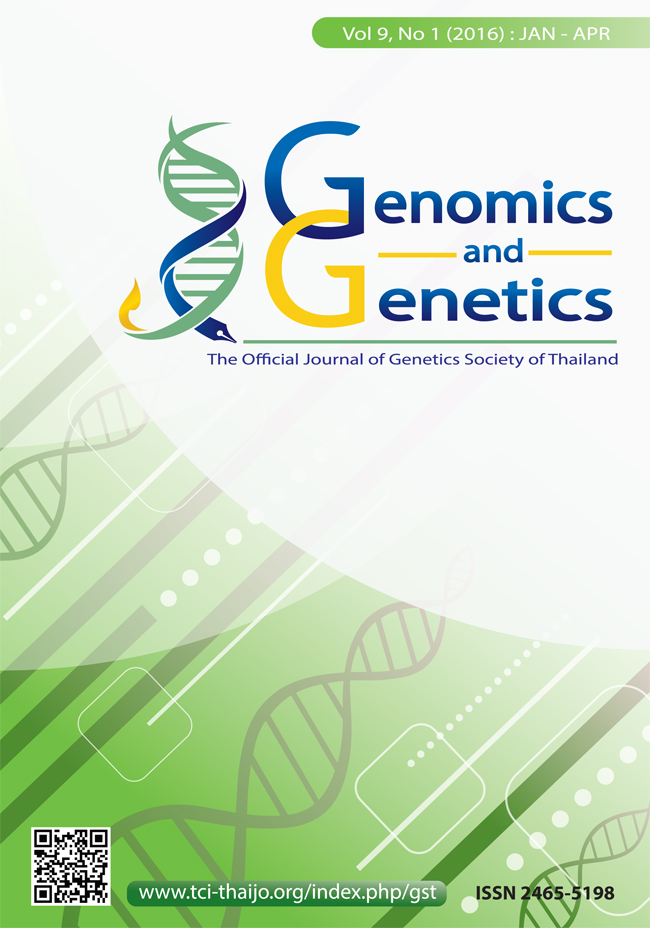Co-amplification of human specific and conserved region in cytochrome b gene confirms human bloodstains
Keywords:
Human bloodstains, Cytochrome b gene, Duplex PCR, Forensic scienceAbstract
The objective of this study was to determine human bloodstains by duplex PCR analysis of cytochrome b gene (Cyt b). Two regions of Cyt b consisting of conserved and human specific regions were the targets of interest. The primers specific to these regions were designed and tested with DNA extracted from human and animal (dog, cat, pig, chicken and cow) blood samples. A PCR product of Cyt b conserved region (~309 bp) was found in both human and animal blood samples while a DNA fragment of human specific region (~412 bp) was seen only in human blood sample. Duplex PCR analysis was then carried out. Human blood could be discriminated from animal blood by the number of amplified fragment, two for human and one for animal blood samples. The duplex PCR analyses of mixed human and animal bloodstains were also investigated. Duplex PCR could determine human DNA even when the quantity of human blood was 100 fold less than that of animal blood. The effects of temperature and age of bloodstains on human blood determination were then examined. Human bloodstain samples were kept at different temperatures (25, 35, 45 and 55°C) for different periods of time (1, 7, 14 and 30 days). The results demonstrated that duplex PCR analysis is able to determine human bloodstains in all experimented conditions.References
Bataille M, Crainic K, Leterreux M, Durigon M, de Mazancourt P (1999) Multiplex amplification of mitochondrial DNA for human and species identification in forensic evaluation. Forensic Sci Int. 99: 165-170.
Barta JL, Monroe C, Crockford SJ, Kemp BM (2014) Mitochondrial DNA preservation across 3000-year-old northern fur seal ribs is not related to bone density: Implications for forensic investigations. Forensic Sci Int. 239: 11-18.
Caine L, Lima G, Pontes L, Abrantes D, Pereira M, Pinheiro MF (2006) Species identification by cytochrome b gene: Caseworks samples. International Congr Ser. 1288: 145-147.
Crouse CA, Schumm J (1995) Investigation of species specificity using nine PCR-based human STR systems. J Forensic Sci. 40: 952-956.
Donfack J, Wiley A (2015) Mass spectrometry-based cDNA profiling as a potential tool for human body fluid identification. Forensic Sci Int: Genetics. 16: 112-120.
Edelman G, Manti V, van Ruth SM, van Leeuwen T, Aalders M (2012) Identification and age estimation of blood stains on colored background by near infrared spectroscopy. Forensic Sci Int. 220: 239-244.
Gomes LAM, Duarte R, Lima DC, Diniz BS, Serrao ML, Labarthe N (2001) Comparison between precipitin and ELISA test in the bloodmeal detection of Aedes aegypti (Linnaeus) and Aedes fluviatilis (Lutz) mosquitoes experimentally fed on feline, canine and human hosts, Mem I Oswaldo Cruz. 96: 693-695.
Henegariu O, Heerema NA, Dlouhy SR, Vance GH, Vogt PH (1997) Multiplex PCR: Critical parameters and step-by-step protocol. BioTechniques. 23: 504-511.
Hurley IP, Cook R, Laughton CW, Pickles NA, Ireland HE, Williams JHH (2009) Detection of human blood by immunoassay for applications in forensic analysis. Forensic Sci Int. 190: 91-97.
Jakubowka J, Maciejewska A, Pawlowski R, Bielawski KP (2013) mRNA profiling for vaginal fluid and menstrual blood identification. Forensic Sci Int: Genetics. 7: 272-278.
Just RS, Loreille OM, Molto JE, Merrriwether DA, Woodward SR, Matheson C, Creed J, McGrath SE, Sturk-Andreaggi K, Coble MD, Irwin JA, Ruffman A, Parr RL (2011) Titanic’s unknown child: The critical role of the mitochondrial DNA coding region in a re-identification effort. Forensic Sci Int: Genetics. 5: 231-235.
Kanthaswamy S, Premasuthan A, Ng J, Satkoski J, Goyal V (2012) Quantitative real-time PCR (qPCR) assay for human-dog-cat species identification and nuclear DNA quantification. Forensic Sci Int: Genetics. 6: 290-295.
Richard MLL, Harper KA, Craig RL, Onorato AJ, Robertson JM, Donfack J (2012) Evaluation of mRNA marker specificity for the identification of five human body fluids by capillary electrophoresis. Forensic Sci Int: Genetics. 6: 452-460.
Matsuda H, Seo Y, Kakizaki E, Kozawa S, Muraoka E, Yukawa N (2005) Identification of DNA of human origin based on amplification of human-specific mitochondrial cytochrome b region. Forensic Sci Int. 152: 109-114.
McLaughlin G, Doty KC, Lednev IK (2014) Discrimination of human and animal blood traces via raman spectroscopy. Forensic Sci Int. 238: 91-95.
Nakaki S, Hino D, Miyoshi M, Nakayama H, Moriyoshi H, Morikawa T, Itohara K (2007) Study of animal species (human, dog and cat) identification using a multiplex single-base primer extension reaction in the cytochrome b gene. Forensic Sci Int. 173: 97-102.
Ono T, Miyaishi S, Yamamoto Y, Yoshitome K, Ishikawa T, Ishizu H (2001) Human identification from forensic materials by amplification of a human-specific sequence in the myoglobin gene. Acta Med Okayama. 55: 175-184.
Parson W, Pegoraro K, Niedertatter H, Foger M, Steinlechner M (2000) Species identification by means of the cytochrome b gene. Int J Legal Med. 114(1-2): 23-28.
Schweers BA, Old J, Boonlayangoor B, Reich KA (2008) Development validation of a novel lateral flow strip test for rapid identification of human blood (Rapid Stain IdentificationTM –Blood). Forensic Sci Int: Genetics. 2: 243-247.
Soejima M, Hiroshige K, Yoshimoto J, Koda Y (2012) Selective quantification of human DNA by real-time PCR of FOXP2. Forensic Sci Int: Genetics. 6: 447-451.
Sullivan KM, Hopgood R, Gill P (1992) Identification of human remains by amplification and automated sequencing of mitochondrial DNA. Int J Legal Med. 105: 83-86.
Suwa N, Ikegaya H, Takasaka T, Nishigaki K, Sakurada K (2012) Human blood identification using the genome profiling method. Legal Med. 14: 121-125.
Tobe SS, Linacre AMT (2008) A technique for the quantification of human and non-human mammalian mitochondrial DNA copy number in forensic and other mixtures. Forensic Sci Int: Genetics. 2: 249-256.
Tsutsumi H, Htay HH, Sato K, Katsumata Y (1987) Antigenic properties of human and animal bloodstains studied by enzyme-linked immunosorbent assay (ELISA) using various antisera against specific plasma proteins. Z Recht Med. 99: 191-196.
Wang Z, Zhang J, Luo H, Ye Y, Yan J, Hou Y (2013) Screening and confirmation of microRNA markers for forensic body fluid identification. Forensic Sci Int: Genetics. 7: 116-123.



